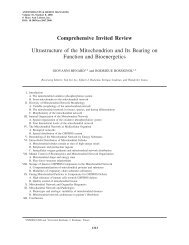MiPsummer Programme pdf - Mitochondrial Physiology Society
MiPsummer Programme pdf - Mitochondrial Physiology Society
MiPsummer Programme pdf - Mitochondrial Physiology Society
Create successful ePaper yourself
Turn your PDF publications into a flip-book with our unique Google optimized e-Paper software.
27<br />
Abstract # 1<br />
Nicotinamide phosphoribosyltransferase knockdown impairs mitochondrial function in mouse myoblasts<br />
Marianne A. Andersen 1 , Sara G. Vienberg 1 , Josef Brandauer 1,2 , Birgitte Holst 3 & Jonas T. Treebak 1 .<br />
1<br />
Section of Integrative <strong>Physiology</strong>, The Novo Nordisk Foundation Center for Basic Metabolic Research,<br />
Faculty of Health and Medical Sciences, University of Copenhagen, Copenhagen.<br />
2 Health Sciences Department, Gettysburg College, Gettysburg PA, USA.<br />
3<br />
Section of Metabolic Receptology and Enteroendocrinology, The Novo Nordisk Foundation Center for Basic<br />
Metabolic Research, Faculty of Health and Medical Sciences, University of Copenhagen, Copenhagen.<br />
In skeletal muscle proper mitochondrial biogenesis and function is critical for maintaining insulin sensitivity<br />
as mitochondrial dysfunction is associated with development of metabolic disorders such as insulin<br />
resistance and type 2 diabetes. A family of energy sensing enzymes called sirtuins deacetylates and thus<br />
activates transcription factors involved in mitochondrial biogenesis. Nicotinamide adenine dinucleotide<br />
(NAD) is a required substrate for sirtuin activation which results in conversion of NAD to nicotinamide<br />
(NAM). NAM directly inhibits sirtuin activity, and resynthesis of NAD is likely essential for maintaining<br />
sirtuin activity. Nicotinamide phosphoribosyltransferase (Nampt) is the ratelimiting enzyme in the<br />
recycling pathway that converts NAM to NAD, but evidence for a role of Nampt in maintaining sirtuin<br />
activity and mitochondrial function is lacking. The aim of the current study was to determine the role of<br />
Nampt in maintaining mitochondrial function in response to metabolic stress such as the transition<br />
between substrate utilization in skeletal muscle cells. We hypothesized that mitochondrial function would<br />
be impaired in absence of Nampt.<br />
We have generated a stable Nampt knockdown (KD) mouse myoblast (C2C12) cell line using a shRNA<br />
lentiviral approach. Nampt mRNA expression and protein abundance was reduced by 80% in the KD cells.<br />
<strong>Mitochondrial</strong> function was determined using a Seahorse X96 Extracellular Flux Analyzer. Basal<br />
mitochondrial respiration was unaffected by Nampt KD compared to cells expressing nonsense shRNA<br />
(control). However, maximal respiratory capacity induced by the oxidative phosphorylation uncoupler<br />
Carbonyl cyanide 4(trifluoromethoxy) phenylhydrazone (FCCP) was significantly (p



